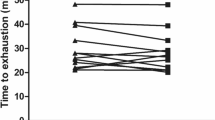Summary
Breathing pattern was studied in six subjects in normoxia (FIO2=0.21) and hypoxia (FIO2=0.12) at rest and during incremental work-rate exercise. Ventilation (V) as well as mean inspiratory flow (VT/TI) increased with exercise intensity and were augmented in the hypoxic environment, whereas the ratio between inspiratory (TI) and total (Ttot) breath durations increased with exercise intensity but was unaffected by hypoxia. The relationship of tidal volume (VT) and inspiratory time duration (TI) showed linear, coinciding ranges for the normoxic and hypoxic conditions up to VT/TI values of about 2.5 l · s−1. At higher VT/TI values TI continued to decrease, whereas VT tended to level off, an effect which was more evident in the hypoxic condition. The results suggest that the hypoxic augmentation of exercise hyperpnea is primarily brought about by an enhancement of central inspiratory drive, the timing component being largely unaffected by the hypoxic environment, and that at low to moderate levels of exercise hyperpnea inspiratory off-switch mechanisms are essentially unaffected by moderate hypoxia.
Similar content being viewed by others
References
Askanazi J, Milic-Emili J, Broell JR, Hyman AI, Kinney JM (1979) Influence of exercise and CO2 on breathing pattern of normal man. J Appl Physiol: Respir Environ Exerc Physiol 47: 192–196
Asmussen E, Nielsen M (1957) Ventilatory response to CO2 during work at normal and low oxygen tensions. Acta Physiol Scand 39: 27–35
Clark FJ, v Euler C (1972) On the regulation of depth and rate of breathing. J Physiol 222: 267–295
Clark JM, Hagerman FC, Gelfand R (1983) Breathing patterns during submaximal and maximal exercise in elite oarsmen. J Appl Physiol: Respir Environ Exerc Physiol 55: 440–446
Euler C v (1984) The contribution of sensory inputs to the pattern of breathing. Can J Physiol Pharmacol 59: 700–706
Ellingsen I, Sydnes G, Hauge A, Nicolaysen G (1985) Effects of exercise and hypercapnia on the breathing pattern in man. Acta Physiol Scand Suppl 542: 36
Hey EN, Lloyd BB, Cunningham DIC, Jukes MGM, Bolton, DPG (1966) Effects of various respiratory stimuli on the depth and frequency of breathing in man. Resp Physiol 1: 193–205
Hornbein TF, Roos A (1962) Effect of mild hypoxia on ventilation during exercise. J Appl Physiol 17: 239–242
Lind FG (1984) Respiratory drive and breathing pattern during exercise in man. Acta Physiol Scand [Suppl 533]
Lind F, Hesser CM (1984) Breathing pattern and occlusion pressure during moderate and heavy exercise. Acta Physiol Scand 122: 61–69
Milic-Emili J, Grunstein MM (1976) Drive and timing components of ventilation. Chest 70: 131–133
Rebuck AS, Rigg JRA, Saunders NA (1976) Respiratory frequency response to progressive isocapnic hypoxia. J Physiol 258: 19–31
Wagner PD (1987) The lungs during exercise. N Physiol Scie 2: 6–10
Author information
Authors and Affiliations
Rights and permissions
About this article
Cite this article
Mekjavic, I.B., Eiken, O., LaPrairie, A. et al. The pattern of breathing during hypoxic exercise. Europ. J. Appl. Physiol. 56, 619–622 (1987). https://doi.org/10.1007/BF00424799
Accepted:
Issue Date:
DOI: https://doi.org/10.1007/BF00424799




